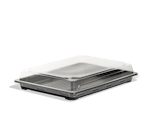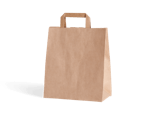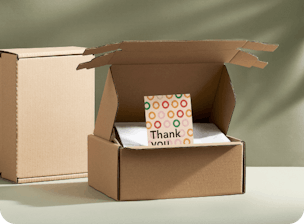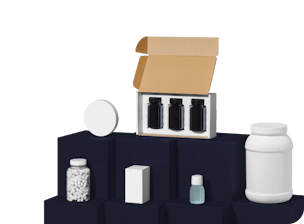Coffee Packaging: Trends and Ways to Keep Your Coffee Fresh

Subscribe to stay updated
You're now subscribed!

Ah, coffee. Nothing beats that first sip of fresh coffee in the morning. The comforting aroma. The warmth of the mug. A taste that awakens your senses.
Just picture it: steam rising from a freshly poured cup. The rich smell fills the air. And then that first indulgent sip.
It's a cherished ritual for many. And an essential part of the day for countless Europeans. In fact, Europe is the world's largest coffee market. This coffee-loving continent made up 32% of global coffee consumption in 2021.

But there's nothing worse than going in for that first sip of nirvana only for your coffee to taste old. Stale. Flavorless. Instantly your day is off to a bad start. And the aftermath? A disappointed customer who'll likely never buy from that same coffee brand again.
So how can you prevent the dreaded fate of stale coffee?
It all comes down to proper coffee packaging. From harvest to first sip, you'll guarantee the best quality coffee encased in your branding.
In this article, you'll learn:
- Factors that play a pivotal role in preserving coffee's freshness.
- The best coffee packaging solutions on the market.
- How to streamline the coffee delivery process.
- Coffee bag design inspiration from top brands.
Coffee's distinctive edge: Why it's not just another food product
Shipping food is a complicated process. You must find the proper packaging to keep it fresh and preserve the flavour. But coffee takes this requirement to another level.
Think of it this way. You can package a loaf of bread in a clear plastic bag, add a twist tie and call it a day. Coffee, on the other hand is not that simple. If you walk down the coffee aisle, you'll see:
- Opaque, vacuum-sealed bags
- Whole bean vs. ground coffee
- Degassing valves and seals
- Airtight coffee tins
Why? At its core, coffee is a symphony of flavours and aromas. But what grants it its rich character and flavour profile makes it challenging to preserve.
Let's break down the main factors that keep coffee fresh.
Oxygen: The silent flavour thief
Freshly roasted coffee beans are a treasure trove of flavours. However, expose them to oxygen, and you'll witness a slow, heartbreaking fade of those intricate notes.
In other words, oxidation is coffee's natural enemy. It turns those flavourful beans stale, flat, and lifeless.
Moisture: The coffee bean's bane
Moisture and coffee have a love-hate relationship. While coffee beans require (a lot of) moisture in the growing process, it becomes an enemy immediately after roasting.
Moisture can compromise the bean's integrity. It leads to mould, off-flavours, and shorter shelf life.
Light: more foe than friend
Like our skin, coffee beans are sensitive to light. Prolonged exposure can break down the essential oils that give coffee its distinctive flavour.
Enter the unsung hero: coffee packaging.
Your packing is more than a vessel to hold the beans. Coffee packaging acts as a fortress. It shields your beloved brew from the elements. It guarantees that every sip resonates with the rich flavours and aromas that coffee aficionados cherish.

The packaging might seem like one of the final steps in the grand scheme of your coffee's journey from the farm to the cup. But this last line of defence determines whether your morning brew is a fresh revelation or a flat disappointment.
Remember, coffee isn't just another food product. It's an experience. It's a lifestyle. And preserving that experience demands respect, knowledge, and the right packaging.
Take note that another essential part of the importance of packaging is how customers feel when they see it. Once it reaches the last stage of becoming a coffee product, ensure that you have an effective coffee shop logo that expresses the quality of your efforts.
Packaging is also the perfect place to show off your brand's personality. More on that later.
The best coffee packaging solutions for fresh coffee
Here are the best coffee packing solutions to preserve your finest roast.
Good: doypacks with resealable zippers
Doypacks are a favourite for a reason. Their resealable zippers make accessing your coffee convenient once opened. And it provides a tight seal to keep out unwanted elements.

This straightforward solution is a popular choice for coffee brands. Especially recyclable paper doypacks are cost-effective and do a good job of keeping your coffee fresh. The flat bottoms are ideal for displaying coffee on retail store shelves or in your customers' pantry.
And that's also why you'll often find this packaging in most local coffee shops and roasteries.
Better: vacuum-sealed bags and tins
Want to extend your coffee's shelf life? Look no further than vacuum-sealed bags and tins.
By removing air from the equation, vacuum-sealed packaging helps maintain your coffee's freshness for longer periods. The result? A consistent flavour with each brew.
Tins and cans are a popular choice for craft roasteries. They're unique. They block out unwanted light. And they provide some of the best airtight seals. So if you want to stand out from the masses, a custom can design is a solid option.
Williams Sonoma, an American gourmet food and cookware brand, packages its coffee the same day it's roasted. Then it vacuum-packs the coffee beans in tins to ensure optimal freshness.

Better yet, this coffee bean packaging stands out from the rest of the bags on the shelves. And their beans are less likely to face damage during shipping.
Best: degassing valves
Freshly roasted coffee beans release carbon dioxide. Without an outlet, this could compromise the package and the bean quality.
Degassing valves solve this problem by letting the gas out without allowing external air inside the bag. And although this sounds like a wild machine, it's quite the opposite. It's so small that most people don't realize it's a core part of a coffee bag.
It looks like a small button. Sometimes, it's called an aroma valve or coffee valve because you can smell the coffee's unique aroma through the valve.

Hawaii is the most isolated population centre in the world. They know a thing or two about protecting the freshness of their 100% Kona coffee during transit.
Mountain Thunder Coffee Plantation says coffee lovers should never buy a bag of coffee without a degassing valve. Why? Degassing valves are the key components to preserving coffee flavours and freshness.
Whole coffee beans maintain their freshness for up to 12 months when stored in:
- Nitrogen-flushed bags with a one-way valve
- A basic pouch equipped with a degassing valve
Nitrogen flushing swaps out oxygen in food packaging for nitrogen. This method preserves food quality, as nitrogen remains neutral. It doesn't affect texture, flavour, or taste. Nitrogen forms a protective barrier around products during transport and shelf storage.
Conversely, vacuum sealing simply extracts all the air from the package before sealing. It doesn't introduce any gasses. The takeaway? Nitrogen flushing is a superior method for packaging coffee over vacuum sealing.
Sustainable packaging: biodegradable and compostable bags
Today, customers are increasingly eco-conscious. They actively seek out retailers who align with their values. And recent data support this claim, with 82% of consumers willing to pay more for sustainable packaging.
Biodegradable and compostable bags are a quality sustainable packaging solution for an eco-conscious consumer base.

When you pick these eco-friendly options, you're preserving the quality of your product. And you build a brand image that resonates with consumers — protecting our planet.
A sustainable choice today can lead to increased customer loyalty tomorrow.
Keep this in mind as you navigate your coffee packaging decisions.
Consistent coffee packaging
When you piece together a hodge podge of various packaging solutions, chances are your branding is not going to be consistent.
That's why looking for a single coffee packaging supplier is worth going the extra mile. Whether you're a coffee subscription service or a basic coffee shop, you want your packaging to be uniform and representative.
In order to verify the quality of your supplier's packaging, order samples of your printed mailer boxes, resealable pouches, custom labels, or anything else you might need.
Try out the materials. Compare the vividness of the print. That's how you know all the pieces together create a cohesive whole.
Ordering a consistent coffee packaging set from a single supplier can:
- Enhance the unboxing experience.
- Elevate your brand's perception.
- Simplify the shipping process and reduce your carbon footprint.
Pro tip: Use mailer boxes for convenience and protection of your coffee pouches and cans. With sturdy exterior boxes to protect the beans, your coffee will reach its destination in optimal condition.
The result? The best cup of coffee. And happy customers.
Beans on the move: Optimising coffee delivery for peak freshness
With proper packaging (and storage), you can increase the shelf life of your coffee. Here's a quick and fast guide:
- Ground coffee in an unopened bag: 2–4 months
- Roasted whole coffee beans in a vacuum-sealed bag: 3–5 months
- Whole coffee beans in an airtight container: 12 months
That's great, right? You have a decent amount of time to get your coffee into the hands of your consumers. But coffee enthusiasts want the best of the best. They want coffee a few days after it's roasted.
While the type of coffee packaging you choose is important, so is the shipping process. Let's dive into how to make that more efficient.
1. Streamline your entire supply chain process
From harvesting to shipping, there are many moving parts in the coffee supply chain. And any serious kinks can impact your ability to deliver the highest quality coffee.
Start by evaluating your current suppliers.
- Are they reliable and timely?
- Are there any bottlenecks in procurement?
Invest in the proper supply chain analytics tools to help you uncover your problem areas. You can access real-time insights into inventory levels, on-time delivery metrics, and order costs.

For example, asset tracking software allows you to check the location and condition of coffee shipments at any given moment.
That's right. You can trace coffee packages from origin to destination. These insights help identify potential issues or delays in real-time. That way, you can take prompt corrective actions as needed.
So wave goodbye to supply chain mishaps with increased transparency and hello to coffee that stays fresh and delicious. Oh, and don't forget about the potential cost savings.
2. Find the right delivery partner
Next, it's time to focus on logistics. The goal? Optimise routes for efficient deliveries. That way, the journey from your packing facility to the store shelves (or customer's doorstep) is as direct as possible.
Collaborate with transportation partners who prioritise punctuality and care in handling your products. Using an express courier service that offers same-day delivery reduces transit time. You can guarantee that your coffee is always fresh upon arrival.
And the best part?
According to research from GoPeople, 88% of customers are willing to pay for same-day delivery. It makes them more likely to shop online.
With the right delivery partner, your biggest coffee fans get the freshest batch every time. The higher price tag for same-day delivery doesn't dent your margins. And you build a competitive edge. It's a win-win.
Inspiration station: coffee brands crushing the packaging game
Packaging is an important part of your brand identity. Follow the leads of these coffee brands to learn how to step up your coffee packaging game.
1. Chamberlain Coffee

Started by YouTuber Emma Chamberlain, Chamberlain Coffee is an ode to passion and brand authenticity.
One of the first things you notice about Chamberlain Coffee's packaging is its chic, modern, and colourful aesthetic. It is perfectly complemented with a creative coffee logo.
The coffee bag design hits the nail on the head for their target market: Gen Z.
The designs often mirror Emma's personal style, featuring hand-drawn doodles and playful graphics. They also use compostable packaging, leading the charge in sustainable coffee packaging practices.
This is a seamless blend of sustainability, personalized charm, and contemporary design. It not only preserves the freshness of the coffee inside but also crafts a memorable unboxing experience for consumers.
Chamberlain Coffee has seen great success since its launch in 2020. With $15 million in funding, a ready-to-drink product on Walmart shelves, the sky's the limit for this trendy coffee brand.
This is a seamless blend of sustainability, personalised charm, and contemporary design. It not only preserves the freshness of the coffee inside but also crafts a memorable unboxing experience for consumers.
Chamberlain Coffee has seen great success since its launch in 2020. With $15 million in funding, a ready-to-drink product on Walmart shelves, the sky's the limit for this trendy coffee brand.
2. Dak Coffee Roasters
Inspired by the real Italian Espresso he first tasted in Milan, Louis-Philippe Boucher realised that coffee is a whole universe of flavours, roasts and brews. He founded Dak Coffee Roasters to celebrate the ritual and explore the experience of coffee drinking.

Dak Coffee Roasters are a company offering monthly subscriptions or one-time buys of the finest filter and espresso coffees from all over the world.
Their mission is to deliver the most amazing coffee experience to anyone who wants it. This means inclusive branding - and simple is the way to do it.
The white mailer box with a basic graphic and logo is a refreshing, minimalistic approach to coffee packaging. It stands out in the hot beverage industry, full of mouth-watering images and intense colours.
Dak Coffee Roasters communicate that for them, it's all about the coffee and the person drinking it, not fancy marketing tactics.
But you need high-quality print and packaging material to achieve such a message.
The company only sells coffee that's ethically sourced. They work sustainability into every aspect of their business - from fair wages to eco-conscious packaging. And this speaks through their unique, plain white box with eco print.
It's a masterclass in minimalistic elegance. Black and white. Devoid of distractions and frills. It is a testament to their philosophy: sometimes, simplicity speaks volumes.
3. Mother Tongue Coffee

In the growing industry of artisanal coffee, Mother Tongue Coffee has found itself a niche. It combines seasoned expertise with a deep commitment to ethics.
Jen Apodaca, the brain behind Mother Tongue, has been roasting since 2005. Her unparalleled roasting skills have graced renowned names like Intelligentsia and Blue Bottle.
One glance at Mother Tongue's packaging has you captivated. It's funky. It's distinctive. And it has a flair that's hard to forget. The design ethos reflects Jen's journey and vision, blending quirkiness with authenticity.
Need inspiration? Check out these amazing food packaging designs
Mother Tongue believes in a sustainable business approach. Their mission is clear: coffee isn't a charity. It's a business. And for it to thrive, every stakeholder, from the farmer to the consumer, should benefit.
4. Ten Belles

At the heart of Ten Belles' roasting operations lies the Loring Falcon. It's a state-of-the-art roaster that perfectly embodies the brand's commitment to the environment. With minimal gas usage and emissions, it's a testament to Ten Belles' dedication to sustainable roasting.
Now, here's where Ten Belles truly shines: their packaging. Ten Belles offers a delightful deviation in an era saturated with single-use packages. They sell their beans in bulk across all their shops. The goal is to reduce packaging waste.
That leads to the crown jewel of their coffee packaging approach: a refillable tin. It allows customers to engage in an eco-friendly shopping experience.
They urge customers to either purchase their signature tins or come prepared with their own containers. It's a conscious move that reduces waste and brings a unique aesthetic appeal.
5. Morgon Coffee Roasters

In the vibrant heart of Gothenburg, during the summer of 2018, a fresh coffee narrative began to percolate. Morgon Coffee Roasters is a recent entrant in the coffee industry. But the seasoned trio behind it bring nearly 40 years of combined coffee wisdom.
For Morgon, the journey from bean to cup is an enchanting one. And they want every customer to feel that same allure. Enter their packaging — a harmonious blend of aesthetics and functionality.
Each bag, short and stocky, is a canvas. Abstract images splash across them. Every package looks like it belongs at an art museum. They've crafted a world where art, experience, and flavour intertwine effortlessly.
What's the best coffee packaging for me?
Deciding on the ideal coffee packaging requires introspection and market awareness. The right choice isn't just about aesthetics or functionality. It reflects your brand's values and objectives.

Ask yourself these questions:
- Am I willing to invest in meticulous packaging techniques like nitrogen flushing?
- Which takes precedence: flavour protection or branding appeal?
- How important is sustainability to my brand's mission?
- What are my financial constraints?
Your answers will guide you toward packaging solutions that align with your brand's ethos and logistical needs.
And if you need help along the way, connect with Packhelp. Our team can provide competitive quotes. And our seasoned packaging engineers are available around the clock. They're ready to share insights on what works best for the coffee industry.
What packaging options will you choose to make a mark in this growing industry?
Author Bio:

Kelly is a self-proclaimed coffee addict who might love her morning java more than most acquaintances. When she's not exploring every coffee shop in town, she's writing content for all the unsuspecting souls of the internet from her perch at Home & Jet. If you read something mediocre online, there's a decent chance Kelly had her caffeinated fingers in it.





































































